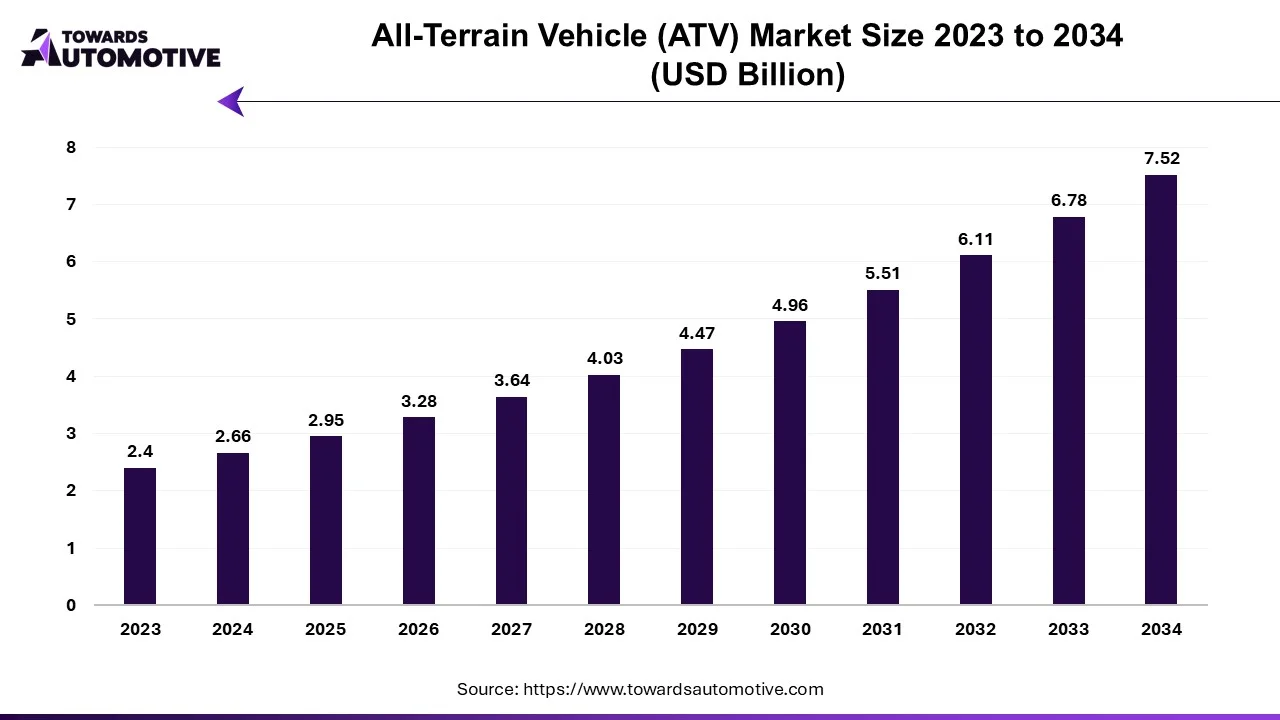October 2025
The global electric ATV market is projected to reach USD 352.4 million by 2034, growing from USD 36.92 million in 2025, at a CAGR of 28.49% during the forecast period from 2025 to 2034.

The Electric All-Terrain Vehicle (ATV) market is experiencing rapid growth as advancements in electric vehicle technology is reshaping the off-roading mobility landscape. Electric ATVs are powered by rechargeable batteries, are gaining significant attention due to their eco-friendliness, reduced noise pollution, and lower operating costs compared to their internal combustion engine (ICE) counterparts. These vehicles are increasingly used across diverse applications, including agriculture, forestry, sports, military, and recreational activities, driving their adoption globally. The growing consumer preference for sustainable and quiet vehicles, coupled with government incentives promoting electric mobility, has further accelerated the shift toward electric ATVs.
Technological advancements, such as improved battery capacities, enhanced torque delivery, and longer driving ranges, are enhancing the appeal of electric ATVs to a wider audience. Manufacturers are also integrating smart features, such as GPS navigation, Bluetooth connectivity, and advanced safety systems, to cater to the evolving demands of consumers. The rising popularity of adventure tourism and outdoor sports is another significant factor fueling market growth, as enthusiasts seek environmentally conscious alternatives for off-road exploration.
Regional markets are witnessing varying growth patterns, with North America leading in recreational and sports applications, while Asia-Pacific is experiencing rising demand in agricultural and industrial sectors. As there are several regulatory frameworks regarding emissions, the market is poised for further expansion, driven by innovation and investment in green technology. The electric ATV market presents immense potential for growth, aligning with the global shift toward electrification and sustainability in the automotive industry.
Artificial Intelligence (AI) is playing a transformative role in the Electric All-Terrain Vehicle (ATV) market, driving innovation, enhancing performance, and improving user experiences. AI-powered systems are being integrated into electric ATVs to enable advanced functionalities such as autonomous navigation, predictive maintenance, and real-time performance optimization. These capabilities not only improve the overall efficiency and reliability of electric ATVs but also expand their applications in industries such as agriculture, forestry, and defense. For instance, AI-enabled sensors and cameras can help electric ATVs autonomously navigate challenging terrains, ensuring precision and safety in tasks like crop monitoring, equipment transportation, or search-and-rescue operations.
Predictive analytics, powered by AI, is another significant application enhancing the electric ATV market. AI algorithms analyze real-time data from the vehicle's components, such as battery health, motor performance, and terrain feedback, to predict potential issues before they arise. This reduces downtime and maintenance costs, making electric ATVs more reliable for users. Additionally, AI integration enables advanced energy management systems, allowing ATVs to optimize battery usage and extend driving range, which is crucial for off-road and remote applications.
AI is also enhancing the user experience by enabling smart features like voice commands, route optimization, and adaptive driving modes tailored to specific terrains or activities. Furthermore, AI-driven customization options allow manufacturers to design electric ATVs that cater to individual preferences and use cases, thereby broadening their appeal. As the electric ATV market evolves, the incorporation of AI technologies is expected to drive significant advancements, offering safer, smarter, and more efficient vehicles.
Rising military expenditure is a key driver in the growth of the Electric ATV market, as defense forces worldwide increasingly prioritize investments in advanced, sustainable, and efficient vehicles. As military budgets expand, there is a growing focus on adopting technologies that provide operational advantages, while reducing long-term costs and environmental impact. Electric ATVs align with these priorities by offering cost-effective solutions with lower maintenance requirements compared to traditional gasoline-powered models.
Electric ATVs are particularly advantageous in tactical and off-road operations, where they provide stealthy movement, reduced noise, and the ability to navigate challenging terrains. Their eco-friendly nature further appeals to military organizations aiming to minimize their carbon footprint, especially in protected environments like nature reserves or wildlife areas.
Additionally, advancements in battery technology have extended the range and improved the reliability of electric ATVs, making them a viable option for military missions that require durable, long-lasting, and low-maintenance vehicles. With growing emphasis on sustainability and innovative technologies in defense, the demand for electric ATVs is expected to rise as military expenditure increases globally, further propelling market growth. The ability to offer stealth, efficiency, and operational flexibility drives the adoption of electric ATVs, making them an integral part of modern military fleets.

The Electric ATV market faces several restraints, including high initial costs compared to traditional gas-powered models, which can deter potential buyers. Additionally, limited charging infrastructure in rural or remote areas restricts usage and convenience. Range anxiety also persists due to concerns over battery life. Moreover, the non-availability of spare parts and the lack of consumer awareness about electric ATVs pose further challenges for market expansion.
The development of autonomous ATVs creates significant opportunities in the electric ATV market, offering transformative potential across several sectors. Autonomous technology in electric ATVs integrates advanced sensors, machine learning, and GPS systems to enable self-driving capabilities, making them highly beneficial for various applications such as agriculture, surveying, and recreational activities. In agriculture, autonomous electric ATVs can efficiently perform tasks such as crop monitoring, land surveying, and transporting goods without the need for manual operation, improving productivity and reducing labor costs. The precision of autonomous systems ensures that tasks are completed more efficiently, with minimal human intervention, leading to greater operational efficiency.
In the recreational sector, autonomous electric ATVs open new opportunities for user experiences. Riders can enjoy off-road adventures without worrying about steering or controlling the vehicle, allowing them to focus more on sightseeing or outdoor exploration. This appeals particularly to those seeking a more relaxed riding experience or those with limited mobility.
Moreover, autonomous electric ATVs can help in improving safety by reducing human error. The integration of safety features such as collision detection, automatic braking, and real-time obstacle avoidance ensures that riders are less likely to be involved in accidents, making these vehicles ideal for use in hazardous environments. As autonomous technologies continue to improve and become more cost-effective, they will provide significant growth opportunities for manufacturers in the electric ATV market, broadening the scope of their applications and enhancing their appeal to a wide range of consumers.
The side-by-side segment held a significant share of the market. The side-by-side segment is a major driver of growth in the electric ATV market due to its versatility, enhanced capacity, and appeal across diverse applications. These vehicles, also known as utility task vehicles (UTVs), are designed to accommodate two or more passengers side-by-side, offering increased functionality compared to traditional ATVs. The rise in demand for SxS electric ATVs is fueled by their ability to combine utility and recreation, making them suitable for industries such as agriculture, construction, and forestry, as well as for leisure activities like off-road adventures and hunting. Their spacious design and higher payload capacity allow for greater utility, making them a preferred choice for transporting equipment, supplies, or passengers over challenging terrains.
The shift toward electrification in the ATV industry has further boosted the popularity of side-by-side vehicles, as these models provide eco-friendly alternatives without compromising performance. Electric SxS ATVs offer advantages such as quieter operations, reduced emissions, and lower maintenance costs, making them particularly attractive for environmentally sensitive applications like farming or eco-tourism. Additionally, advancements in battery technology have significantly enhanced the range and power of electric SxS ATVs, enabling them to tackle demanding tasks with ease.
The recreational appeal of side-by-side vehicles also contributes to their growth, as their comfortable seating, safety features, and off-road capabilities make them ideal for group outings and family adventures. With rising consumer awareness of sustainability and the increasing availability of advanced electric side-by-side models, this segment is expected to drive substantial growth in the electric ATV market.
The 2WD segment led the industry. The 2WD (two-wheel drive) segment is a significant driver of growth in the electric ATV market, owing to its efficiency, affordability, and suitability for a wide range of applications. Electric ATVs with 2WD configurations provide power to two wheels, typically the rear ones, making them a cost-effective choice for consumers who require dependable performance on moderate terrains. These vehicles are particularly popular among recreational users, beginners, and those engaging in lighter tasks, such as trail riding, farming, or yard work. Their relatively simple design and reduced mechanical complexity result in lower production costs, making 2WD electric ATVs more affordable compared to their 4WD counterparts. This affordability broadens their appeal to a larger consumer base, especially in cost-sensitive markets.
The growing popularity of eco-friendly recreational activities has further fueled the demand for 2WD electric ATVs. They offer quieter operation and zero emissions, making them an ideal option for individuals seeking environmentally sustainable off-road experiences. The advancements in electric motors and battery technology have also enhanced the performance, range, and reliability of 2WD electric ATVs, addressing concerns about power and endurance, even for extended use.
Moreover, 2WD electric ATVs are favored in applications where agility, maneuverability, and efficiency are prioritized over rugged off-road capabilities. For example, in agricultural and landscaping settings, these vehicles are utilized for tasks like transporting equipment and supplies across relatively flat or mildly uneven terrain. Their lightweight design improves energy efficiency, ensuring longer operational hours on a single charge. As the demand for affordable, efficient, and eco-friendly transportation solutions continues to rise, the 2WD segment is poised to drive significant growth in the electric ATV market.
North America dominated the electric ATV market. Technological advancements, growing environmental awareness, and improvements in battery technology are significantly driving the growth of the electric ATV market in North America. Technological advancements have led to the development of electric ATVs with enhanced performance features, such as advanced suspension systems, better terrain handling, and integrated smart technologies like GPS tracking and real-time diagnostics. These innovations have elevated the overall riding experience, making electric ATVs more appealing for both recreational and utility purposes. With these advancements, electric ATVs are increasingly viewed as a competitive alternative to traditional gas-powered models, attracting a wider audience of consumers.
Growing environmental awareness has also played a pivotal role in the market's expansion. As concerns about climate change and air pollution rise, North American consumers are becoming more conscious of their environmental footprint. Electric ATVs offer a sustainable solution by eliminating harmful emissions, making them highly attractive to eco-conscious consumers who are interested in eco-tourism, recreational parks, and nature reserves.
Advancements in battery technology are another key factor contributing to the market's growth. With the development of more efficient, long-lasting, and faster-charging batteries, electric ATVs now offer better range and performance. Lithium-ion batteries have become more affordable and reliable, allowing manufacturers to provide higher-quality electric models that cater to the needs of outdoor enthusiasts. These improvements in battery technology make electric ATVs more viable for long-distance rides, contributing to their increasing adoption in North America.
Asia Pacific is expected to grow with the highest CAGR during the forecast period. The growth of the electric ATV market in the Asia Pacific (APAC) region is significantly influenced by the increasing popularity of recreational activities, supportive government incentives, and the expanding use of electric ATVs in utility and agricultural applications.
The increased popularity of recreational activities such as trail riding and off-roading, are becoming increasingly popular in APAC, especially in countries like China, Japan, and Australia. As outdoor enthusiasts seek eco-friendly alternatives to traditional gas-powered ATVs, electric ATVs offer a quieter, more sustainable option. These vehicles are well-suited for activities in natural parks, forests, and protected areas where there are numerous environmental concerns.
Also, APAC governments are introducing a range of incentives, subsidies, and policies to promote the adoption of electric vehicles, including electric ATVs. Countries like China and India have implemented electric vehicle subsidies, tax benefits, and infrastructure developments that make electric ATVs more accessible and attractive to consumers. These incentives align with regional environmental goals, including reducing carbon emissions and improving air quality.
Moreover, electric ATVs are also gaining traction in agricultural and utility sectors in APAC. These vehicles are used for tasks like land surveying, equipment transportation, and farm management. Their ability to operate quietly and without exhaust emissions makes them suitable for farms, forests, and other sensitive environments. As agriculture in the region becomes more technologically advanced and sustainability-focused, the demand for electric ATVs in utility applications continues to rise.
The all-terrain vehicle market is forecast to grow from USD 2.95 billion in 2025 to USD 7.52 billion by 2034, driven by a CAGR of 10.94% from 2025 to 2034. The increasing popularity of outdoor recreational activities in developed nations coupled with technological advancements in the automotive sector is playing a vital role in shaping the industrial landscape.
Additionally, the rapid adoption of electric ATVs in the military sector along with rising disposable income of the people in developing nations has boosted the market expansion. The research and development activities related to ATV batteries is expected to create ample growth opportunities for the market players in the upcoming days.

The all-terrain vehicle (ATV) market is a prominent branch of the automotive industry. This industry deals in manufacturing and distribution of ATVs in different parts of the world. These ATVs are powered by different types of engines consisting of less than 400 cc, 400 cc-800 cc and more than 800 cc. It finds application in various sectors comprising of sports, entertainment, agriculture, military, hunting and some others. The rising interest of youths towards adventure travelling has contributed to the overall industrial growth. This market is expected to rise significantly with the growth of the recreational vehicles industry around the globe.

By Vehicle Type
By Battery Capacity
By Motor Power
By Drive
By Application
By Region
October 2025
October 2025
October 2025
September 2025
We offer automotive expertise for market projections and customizable research, adaptable to diverse strategic approaches.
Contact Us